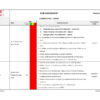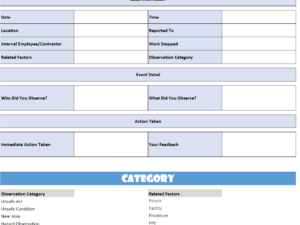Key Elements:
- Potential Hazards Considered:
- Falls from height
- Falling materials
- Fire risk
- Electricity hazards
- Adverse weather conditions
- Deep excavation
- Slips/trips
- COSHH (Control of Substances Hazardous to Health)
- Persons at Risk:
- Employees
- Subcontractors
- Mandatory Health, Safety, and Environment (HSE) Requirements:
- Safety induction
- Tool box talks
- Proper PPE (Personal Protective Equipment)
- Safe workplace
- Work permit
- Proper tools and equipment
- Proper supervision
- Barricades and warning signs
- PPE Requirements:
- Safety helmets
- Safety boots
- Masks
- Overalls
- Respiratory/breathing apparatus
- Full body safety harness
- Risk Levels and Control Measures:
- Unfit/Untrained Operatives: Ensure operatives are physically fit and trained for confined space activities. Address SWMS and risk assessment before entry.
- Limited Access/Exit: Provide safe access and exit, complete pre-entry checklist, have rescue procedures and trained personnel ready.
- Oxygen Deficiency: Conduct atmospheric tests, use forced air ventilation, and monitor oxygen levels.
- Flammable/Toxic Gases: Test for gases, avoid using gas-emitting equipment, follow MSDS for COSHH materials, and use proper ventilation.
- Hot Work/Fire: Obtain hot work permit, ensure ventilation, avoid flammable materials, and provide fire protection equipment.
- Lack of Lights/Communication: Provide sufficient lighting and communication tools, maintain a confined space register.
- High Temperature/Humidity: Provide hydration, ventilation, follow shift systems, and ensure close supervision.
Ongoing Process:
Risk assessment is a continuous process and must be reviewed regularly to adapt to new activities and risks, ensuring a safe working environment.














 Confined Space Entry Risk Assessment: The attached document is a powerful tool for identifying and mitigating risks associated with confined space entry. It’s more than just a form—it’s a proactive step toward safety excellence.
Confined Space Entry Risk Assessment: The attached document is a powerful tool for identifying and mitigating risks associated with confined space entry. It’s more than just a form—it’s a proactive step toward safety excellence.





![84f4d689-b43a-4011-baf2-c5a7cbd51dd8 Risk Assessments Package [70 RA Files]](https://hsefiles.com/wp-content/uploads/2022/04/84f4d689-b43a-4011-baf2-c5a7cbd51dd8-300x225.png)


TOMAS PORTUGAL –
5 star
Rajesh Kumar Singh –
5
Mohamed ibrahim –
Thank you so much
Mohamed –
Outstanding
Shubham Chaudhary –
5 rating
Shubham Chaudhary –
Good…I require this.
Bernice Suma –
4
TOMAS PORTUGAL –
dgdc
TOMAS PORTUGAL –
good
TOMAS PORTUGAL –
Very good
khaled Abdelhay –
excellent